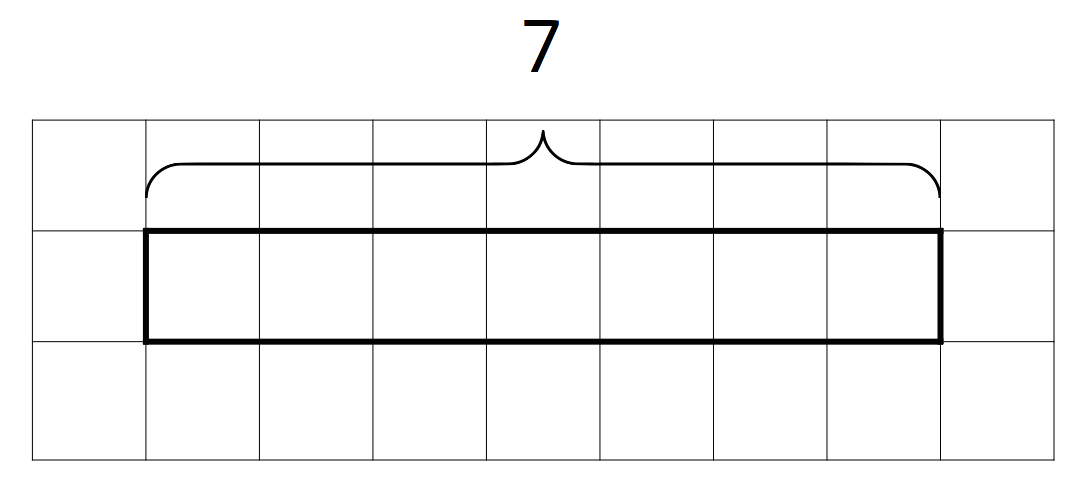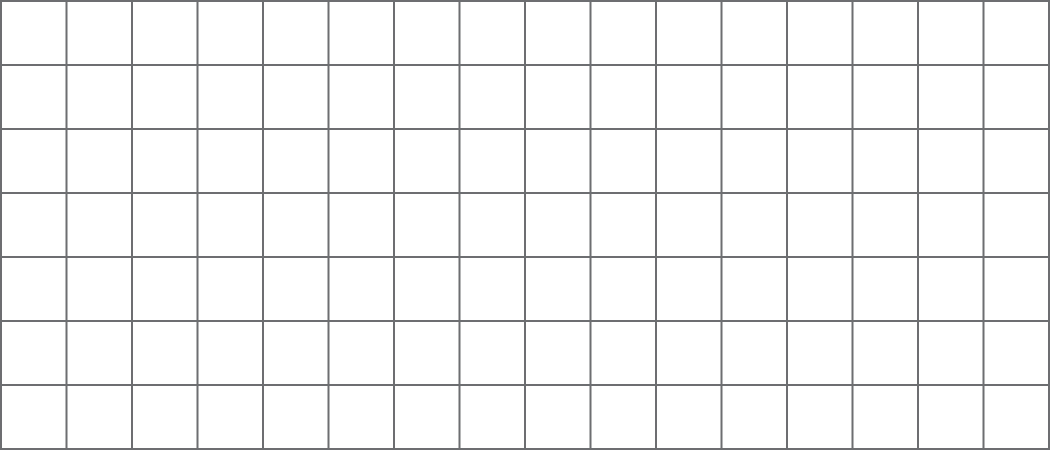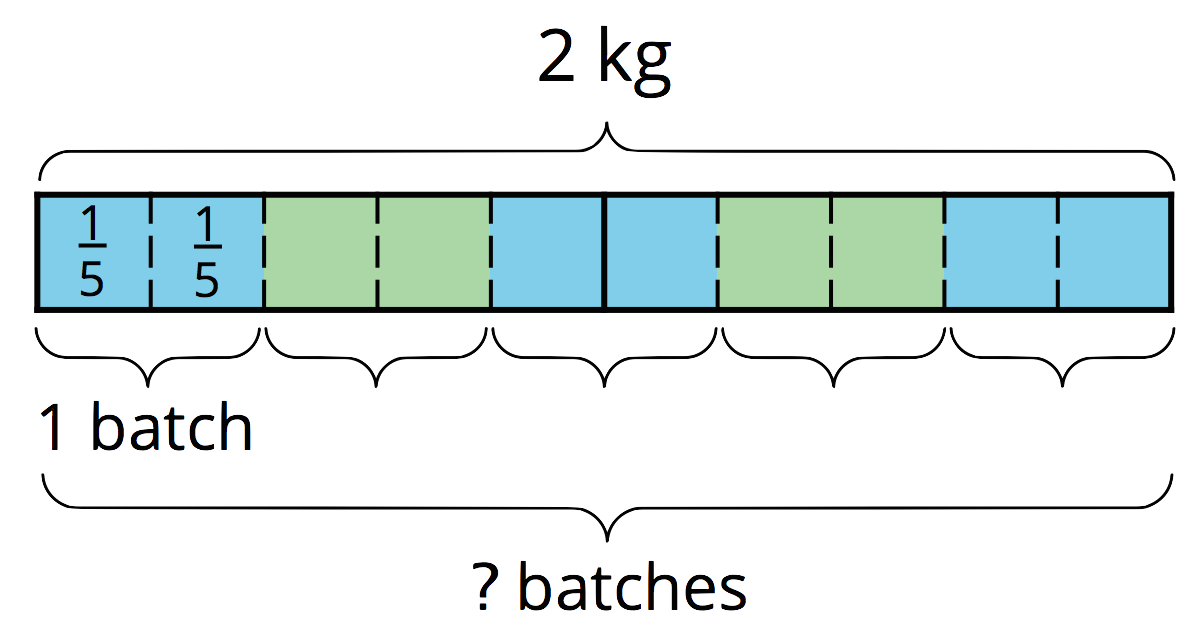Lesson 6
Using Diagrams to Find the Number of Groups
6.1: How Many of These in That? (5 minutes)
Warm-up
Students have previously seen tape diagrams used to represent equal-sized groups. This warm-up gives students a chance to create tape diagrams to represent division expressions in a scaffolded way. Each tape is started on a grid and pre-labeled with the known quantity. Each grid square represents 1.
Launch
Arrange students in groups of 2. Give students 2 minutes of quiet work time and another minute to share their diagrams with their partner.
Student Facing
- We can think of the division expression \(10 \div 2\frac12\) as the question: “How many groups of \(2\frac 12\) are in 10?” Complete the tape diagram to represent this question. Then find the answer.

- Complete the tape diagram to represent the question: “How many groups of 2 are in 7?” Then find the answer.

Student Response
For access, consult one of our IM Certified Partners.
Activity Synthesis
Select a few students to share their diagrams and answers. After each person shares, poll the class to see if others agree or disagree.
Discuss questions such as:
- “How did you know how large each part of the diagram should be?”
(In the first question, the length of the tape represents 10, and there are 10 grid squares, so each grid represents 1. Since the size of each group is \(2\frac12\), each part needs to have \(2\frac12\) squares.) - “In the second question, we see three groups of 2 and an extra square of 1. How did you know that the 1 is \(\frac12\) of a group and not \(\frac17\) of a group?” (The question asks “how many groups of 2 . . .,” so the size of each group is 2, not 7.)
Tell students they will use tape diagrams to help solve other division problems.
6.2: Representing Groups of Fractions with Tape Diagrams (20 minutes)
Activity
In this lesson, students transition away from using concrete tools (pattern blocks and fraction strips) for reasoning about division to using a tool that is more abstract and more flexible. To represent “how many groups?” or “how many of this in that?” questions, they draw tape diagrams on a grid.
Students continue to write multiplication and division equations to make sense of given situations, but here, they also think about the reasonableness of their answers. They see that the solution to a division problem can be checked using the corresponding multiplication equation.
Some students may write answers as fractions and others as mixed numbers. Both are acceptable. Depending on the situation, one may be more useful than the other. For example, in a measurement situation, a mixed number is easier to interpret, but if we need to perform further calculations with an answer, a fraction is easier to work with. In the course of the unit, students should become comfortable with both forms and be flexible in using them.
Launch
Arrange students in groups of 3–4. Tell students that they have solved “how many groups?” and “how many of this in that?” problems using pattern blocks and fraction strips. Now they will solve them by drawing tape diagrams.
Give students 2–3 minutes to discuss the first question and write their response. Follow with a brief whole-class discussion. Select 1–2 students to explain how a tape diagram shows us how many \(\frac 23\)s are in 1.
Then, give students 8–10 minutes of quiet work time to complete the rest of the task. Ask them to discuss their diagrams only after attempting at least 2 of the 3 remaining questions. Provide access to colored pencils. Some students may find it helpful to identify whole groups and partial groups on a tape diagram by coloring.
Supports accessibility for: Visual-spatial processing; Organization
Design Principle(s); Maximize meta-awareness
Student Facing
To make sense of the question “How many \(\frac 23\)s are in 1?,” Andre wrote equations and drew a tape diagram.
\(\displaystyle {?} \boldcdot \frac 23 = 1\)
\(\displaystyle 1 \div \frac 23 = {?}\)

-
In an earlier task, we used pattern blocks to help us solve the equation \(1 \div \frac 23 = {?}\). Explain how Andre’s tape diagram can also help us solve the equation.
-
Write a multiplication equation and a division equation for each question. Then, draw a tape diagram and find the answer.
- How many \(\frac 34\)s are in 1?

- How many \(\frac23\)s are in 3?

- How many \(\frac32\)s are in 5?

- How many \(\frac 34\)s are in 1?
Student Response
For access, consult one of our IM Certified Partners.
Anticipated Misconceptions
Students may misinterpret the given diagram and think that the answer can only be a whole number because in the diagram, “1 group” is shaded, but the fraction of a group is not. Remind students of their work with pattern blocks in which we saw that the answer to the question “how many of this in that?” or “how many rhombuses are in a trapezoid” could involve a whole number and a fraction.
Activity Synthesis
Focus the whole-class discussion on two goals: reflecting on the process of creating and using the diagrams, and discussing how we can check our solutions.
For each problem in the second question, select a student to share their response and ask how many others had the same diagram.
If students’ diagrams cannot be easily displayed for all to see, consider showing the ones in the Possible Responses. To help students reflect on their process, discuss:
- “How did you begin the diagram? How did you know how to partition the pieces in the diagram?”
- “Which of the two equations—multiplication or division—was helpful in setting up the diagram? How so?”
- “How did you determine how many groups there are?”
- “Can we use pattern blocks to represent these situations? Which might be preferable and why?”
Reinforce the idea that the size of 1 group is what we use as the unit for counting and to find out how many groups there are.
To prompt students to think about the reasonableness of their answers, ask: “How would you know if your answer is correct?” If not mentioned by students, point out how to use multiplication to check their solution to the division problem. For example:
- We wrote \({?} \boldcdot \frac 23 = 1\) to represent “how many \(\frac 23\) are in 1?”.
- We found the answer to be \(1\frac12\), so we can substitute \(1\frac12\) for the “?” and see if \(1\frac12 \boldcdot \frac23\) is indeed 1.
- \(1\frac12 = \frac 32\), so we can rewrite that expression as \(\frac 32 \boldcdot \frac 23\).
- \(\frac 32 \boldcdot \frac 23 = 1\), so the answer is correct.
For classes using the digital materials, consider demonstrating an applet to represent a division problem https://ggbm.at/atUteypU. This video shows how to use the tool to answer the question “How many \(\frac12\) are in 3?” https://vimeo.com/184879045.
6.3: Finding Number of Groups (15 minutes)
Activity
In this activity, students apply the reasoning and strategies from the previous activity to solve division problems in context. Though the instructions do not prompt students to draw tape diagrams, students may find them to be a handy option.
Students may also choose to express each whole-number or mixed-number dividend as a fraction. For example, they may express the 6 inches as \(\frac{48}{8}\) inches and then see how many \(\frac38\)s are in \(\frac{48}{8}\). As students work, notice the different strategies they use.
Launch
Keep students in the same groups. Give students 8–10 minutes of quiet work time followed by a few minutes to discuss their work with their group.
Some students may wish to use graph paper to draw tape diagrams and colored pencils to mark up parts of the diagrams. Provide access to geometry toolkits. Encourage students to think about the tools and strategies at their disposal and to check their solutions using multiplication.
Student Facing
-
Write a multiplication equation or a division equation for each question. Then, find the answer and explain or show your reasoning.
-
How many \(\frac38\)-inch thick books make a stack that is 6 inches tall?
-
How many groups of \(\frac12\) pound are in \(2\frac 34\) pounds?
-
- Write a question that can be represented by the division equation \(5 \div 1\frac12 = {?}\). Then, find the answer and explain or show your reasoning.
Student Response
For access, consult one of our IM Certified Partners.
Activity Synthesis
Because the activity is intended to help students reason about division problems quantitatively and abstractly, consider wrapping it up by asking students to write a brief reflection about their reasoning. Display the following prompts for all to see and ask students to write their response on an index card or a sheet of paper so it can be collected.
“A friend is unsure what \(2 \div \frac45\) means and isn't sure how to find its value. How would you help your friend make sense of the expression? How do you think about it? Share two ways that you find helpful for reasoning about an expression like this.”
Design Principle(s): Optimize output; Cultivate conversation
Lesson Synthesis
Lesson Synthesis
In this lesson, we used tape diagrams to find the number of groups in division situations involving fractions. Consider asking some of the following questions:
-
“In the question ‘how many \(\frac34\)s are in 6?’ (or \(6 \div \frac34 = {?}\)), what does each number represent?” (\(\frac34\) represents the size of each group. 6 is the total amount.)
-
“What would a tape diagram for this situation show?” (A total tape length representing 6, broken into parts of \(\frac34\) each.)
-
“How does the diagram help us answer the question?” (It allows us to see and count the number of groups.)
-
“What if that length cannot be broken equally into \(\frac34\)s? How do we deal with the remainder?” (We can think of it as a partial group. We can compare it to the size of 1 group and see what fraction of a group it is.)
-
“We have used pattern blocks, fraction strips, and other diagrams to help us think about division with fractions. How are tape diagrams and these other tools alike?” (They all allow us to represent equal-sized groups so we can see the relationships between the numbers.)
-
“How are tape diagrams different than those tools for reasoning about, say, \(6 \div \frac34\) or \(18 \div \frac 25\)?” (Tape diagrams may be more practical since we can specify what the length of the tape and what each part represent. If we use pattern blocks, we may need a lot of blocks to represent certain numbers. If we use fraction strips, we may need to draw much longer strips. Also, not all fractions are shown on the strips, so we may need to add them.)
6.4: Cool-down - How Many in 2? (5 minutes)
Cool-Down
For access, consult one of our IM Certified Partners.
Student Lesson Summary
Student Facing
A baker used 2 kilograms of flour to make several batches of a pastry recipe. The recipe called for \(\frac25\) kilogram of flour per batch. How many batches did she make?
We can think of the question as: “How many groups of \(\frac25\) kilogram make 2 kilograms?” and represent that question with the equations:
\(\displaystyle {?} \boldcdot \frac25=2\)
\(\displaystyle 2 \div \frac25 = {?}\)
To help us make sense of the question, we can draw a tape diagram. This diagram shows 2 whole kilograms, with each kilogram partitioned into fifths.

We can see there are 5 groups of \(\frac 25\) in 2. Multiplying 5 and \(\frac25\) allows us to check this answer: \(5 \boldcdot \frac 25 = \frac{10}{5}\) and \(\frac {10}{5} = 2\), so the answer is correct.
Notice the number of groups that result from \(2 \div \frac25\) is a whole number. Sometimes the number of groups we find from dividing may not be a whole number. Here is an example:
Suppose one serving of rice is \(\frac34\) cup. How many servings are there in \(3\frac12\) cups?
\(\displaystyle {?}\boldcdot \frac34 = 3\frac12\)
\(\displaystyle 3\frac12 \div \frac34 = {?}\)

Looking at the diagram, we can see there are 4 full groups of \(\frac 34\), plus 2 fourths. If 3 fourths make a whole group, then 2 fourths make \(\frac 23\) of a group. So the number of servings (the “?” in each equation) is \(4\frac23\). We can check this by multiplying \(4\frac23\) and \(\frac34\).
\(4\frac23 \boldcdot \frac34 = \frac{14}{3} \boldcdot \frac34\), and \(\frac{14}{3} \boldcdot \frac34 = \frac{14}{4}\), which is indeed equivalent to \(3\frac12\).